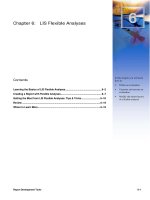Tài liệu Chapter 5: Force and Motion pdf
Bạn đang xem bản rút gọn của tài liệu. Xem và tải ngay bản đầy đủ của tài liệu tại đây (266.25 KB, 12 trang )
Chapter 5
Force and Motion
In chapters 2 and 4 we have studied “kinematics” i.e. described the motion of
objects using parameters such as the position vector, velocity and acceleration
without any insights as to what caused the motion. This is the task of chapters 5
and 6 in which the part of mechanics known as “dynamics” will be developed.
In this chapter we will introduce Newton’s three laws of motion which is at the
heart of classical mechanics. We must note that Newton’s laws describe
physical phenomena of a vast range. For example Newton’s laws explain the
motion of stars and planets. We must also note that Newton’s laws fail in the
following two circumstances: 1. When
the speed of objects approaches (1% or more) the speed of light in vacuum (c =
8×10
8
m/s). In this case we must use Einstein’s special theory of relativity
(1905) 2. When
the objects under study become very small (e.g. electrons, atoms etc) In this
case we must use quantum mechanics (1926) (5-1)
Newton’s First Law
Scientists before Newton thought that a force (the word “influence” was used)
was required in order to keep an object moving at constant velocity. An object
was though to be in its “natural state” when it was at rest. This mistake was
made before friction was recognized to be a force. For example, if we slide an
object on a floor with an initial speed v
o
very soon the object will come to rest.
If on the other hand we slide the same object on a very slippery surface such as
ice, the object will travel a much larger distance before it stops. Newton
checked his ideas on the motion of the moon and the planets. In space there is
no friction, therefore he was able to determine the correct form of what is since
known as : “Newton’s first law”
If the no force acts on a body, the body’s velocity cannot
change; that is the body cannot accelerate
(5-2)
Note: If several forces act on a body (say , , and ) the net force
is defined as: i.e. is the vector sum of , , and
A B C net
nenet A B CC t A B
F F F F
F F F FF F F F= + +
r r r r
rr rr r rr r
Note: If several forces act on a body
(say , , and ) the net force
is defined as:
i.e. is the vector sum of
, , and
A B C net
ne
net A B
C
C
t
A B
F F F F
F
F F F
F F F F= + +
r r r r
r
r
r
r r
r
r
r
Force: The concept of force was tentatively defined as a
push or pull exerted on an object. We can define a force
exerted on an object quantitatively by measuring the
acceleration it causes using the following procedure
We place an object of mass m = 1 kg on a frictionless surface and measure the
acceleration a that results from the application of a force F. The force is
adjusted so that a = 1 m/s
2
. We then say that F = 1 newton (symbol: N)
(5-3)
F
a
o
m
o
F
a
X
m
X
Mass: Mass is an intrinsic characteristic of a body that
automatically comes with the existence of the body. But
what is it exactly? It turns out that mass of a body is the
characteristic that relates a force F applied on the body
and the resulting acceleration a.
Consider that we have a body of mass m
o
= 1 kg on which we apply a force
F = 1 N. According to the definition of the newton , F causes an acceleration
a
o
= 1 m/s
2
. We now apply F on a second body of unknown mass m
X
which
results in an acceleration a
X
. The ratio of the accelerations is inversely
proportional to the ratio of the masses
o o
X
X o
o X X
a a
m
m m
m a a
= → =
Thus by measuring a
X
we are able to determine the mass m
X
of any object.
(5-4)
F
net
a
m
Newton’s Second Law
The results of the discussions on the relations between the net force F
net
applied
on an object of mass m and the resulting acceleration a can be summarized in
the following statement known as: “Newton’s second law”
The net force on a body is equal to the product
of the body’s mass and its acceleration
In equation form Newton’s second law can be written as:
net
F ma=
r
r
The above equation is a compact way of summarizing three separate
equations, one for each coordinate axis:
,net x x
F ma=
,net y y
F ma
=
,net z z
F ma
=
(5-5)









